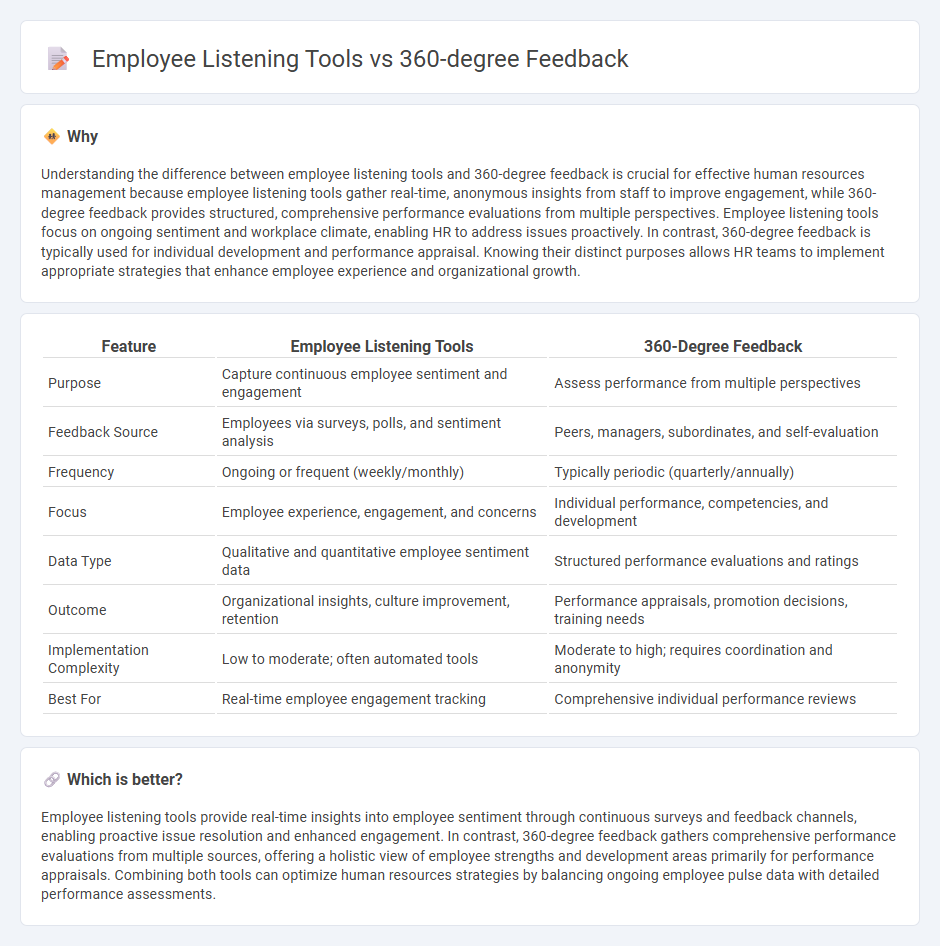
Employee listening tools gather real-time insights through surveys, pulse checks, and feedback platforms to capture employee sentiment and improve engagement. 360-degree feedback involves comprehensive performance evaluations from peers, supervisors, and direct reports to provide a well-rounded view of an employee's strengths and development areas. Explore how combining these approaches can enhance talent management and organizational culture.
Why it is important
Understanding the difference between employee listening tools and 360-degree feedback is crucial for effective human resources management because employee listening tools gather real-time, anonymous insights from staff to improve engagement, while 360-degree feedback provides structured, comprehensive performance evaluations from multiple perspectives. Employee listening tools focus on ongoing sentiment and workplace climate, enabling HR to address issues proactively. In contrast, 360-degree feedback is typically used for individual development and performance appraisal. Knowing their distinct purposes allows HR teams to implement appropriate strategies that enhance employee experience and organizational growth.
Comparison Table
| Feature | Employee Listening Tools | 360-Degree Feedback |
|---|---|---|
| Purpose | Capture continuous employee sentiment and engagement | Assess performance from multiple perspectives |
| Feedback Source | Employees via surveys, polls, and sentiment analysis | Peers, managers, subordinates, and self-evaluation |
| Frequency | Ongoing or frequent (weekly/monthly) | Typically periodic (quarterly/annually) |
| Focus | Employee experience, engagement, and concerns | Individual performance, competencies, and development |
| Data Type | Qualitative and quantitative employee sentiment data | Structured performance evaluations and ratings |
| Outcome | Organizational insights, culture improvement, retention | Performance appraisals, promotion decisions, training needs |
| Implementation Complexity | Low to moderate; often automated tools | Moderate to high; requires coordination and anonymity |
| Best For | Real-time employee engagement tracking | Comprehensive individual performance reviews |
Which is better?
Employee listening tools provide real-time insights into employee sentiment through continuous surveys and feedback channels, enabling proactive issue resolution and enhanced engagement. In contrast, 360-degree feedback gathers comprehensive performance evaluations from multiple sources, offering a holistic view of employee strengths and development areas primarily for performance appraisals. Combining both tools can optimize human resources strategies by balancing ongoing employee pulse data with detailed performance assessments.
Connection
Employee listening tools and 360-degree feedback are interconnected by providing comprehensive insights into employee experiences and performance from multiple perspectives. These tools collect real-time data on employee sentiments, enabling organizations to identify strengths and areas for improvement, which complements the holistic evaluation offered by 360-degree feedback involving peers, managers, and subordinates. Leveraging both approaches enhances talent management, promotes continuous development, and fosters a transparent workplace culture.
Key Terms
Multi-rater assessment
360-degree feedback utilizes multi-rater assessments by gathering performance evaluations from supervisors, peers, subordinates, and sometimes customers, offering a comprehensive view of an employee's skills and behaviors. Employee listening tools capture ongoing employee sentiments and engagement levels through surveys, polls, and open-ended responses but typically lack the structured, multi-source performance feedback found in 360-degree reviews. Explore how integrating multi-rater assessment within employee listening strategies can enhance performance insights and organizational development outcomes.
Continuous feedback
360-degree feedback gathers comprehensive performance insights from peers, managers, and subordinates, fostering holistic employee evaluations. Employee listening tools continuously capture real-time sentiments, enabling organizations to promptly address concerns and enhance engagement. Explore how integrating both approaches can drive effective continuous feedback systems.
Engagement surveys
360-degree feedback provides multi-source performance insights by collecting evaluations from peers, supervisors, and subordinates, enhancing individual development and accountability. Employee listening tools, particularly engagement surveys, gather broad organizational sentiment, identifying trends and areas for improvement in workplace culture and employee satisfaction. Explore the distinctions between these methods to optimize your company's employee engagement strategy.
Source and External Links
10 Examples of How to Give 360deg Feedback to Your Boss in 2025 - 360-degree feedback is a review process involving gathering anonymous, multi-perspective feedback on an employee's performance from colleagues, managers, and others to boost engagement, increase self-awareness, and improve work relationships and productivity.
What is 360 Degree Feedback? - CustomInsight - It is a confidential evaluation system where employees get anonymous feedback from multiple rater groups (managers, peers, direct reports) through rating scales and comments, providing a comprehensive performance view and helping develop improvement plans.
360 Degree Feedback: Process, Examples & Template - Personio - This feedback process expands traditional manager-only reviews by including input from managers, peers, direct reports, self-assessment, and optional external stakeholders, offering a holistic and comprehensive evaluation of employee performance.
 dowidth.com
dowidth.com